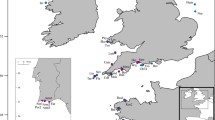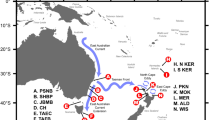Abstract
Seagrass beds are ecologically and economically important coastal ecosystems, and seagrass-associated organisms are a key part of their biodiversity. Marine organisms that reproduce through broadcast spawning are likely to have less genetic differentiation among populations than those that use other modes of reproduction, but this has not been well studied. Here, we investigated the genetic diversity, genetic differentiation, and migration patterns of the seagrass-associated sea star Protoreaster nodosus across 12 sites spanning approximately 2500 km from the Ryukyu Archipelago, Japan, to the Philippines. We genotyped 405 individuals by using seven microsatellite loci and analyzed allelic richness and expected heterozygosity as indices of genetic diversity. Of these two indices, only expected heterozygosity decreased slightly with increasing latitude. These results suggest that genetic diversity has not clearly decreased, even in the isolated Ryukyu Archipelago populations. Geographic distance was significantly correlated with genetic differentiation (pairwise FST: − 0.005 to 0.049). However, populations in the Ryukyu Archipelago and the Philippines showed relatively low genetic structuring and the pairwise genetic differentiation between these regions was often non-significant. Analysis of historical migration rates showed bidirectional north–south migration, which appears to be influenced by the Kuroshio Current and its countercurrents.






Similar content being viewed by others
Data availability
Microsatellite data are available in the electronic supplementary material.
References
Antao T, Lopes A, Lopes RJ, Beja-Pereira A, Luikart G (2008) Lositan: a workbench to detect molecular adaptation based on a Fst-outlier method. BMC Bioinformatics 9:323
Antokhina TI, Britayev TA (2012) Sea stars and their macrosymbionts in the bay of Nhatrang, Southern Vietnam. Paleontol J 46:894–908
Arriesgado DM, Lian C, Kurokochi H, Nakajima Y, Matsuki Y, Fortes MD, Uy WH, Nadaoka K (2015) Genetic diversity and structure of a tropical seagrass Cymodocea serrulata spanning its central diversity hotspot and range edge. Aquat Ecol 49:357–372
Arriesgado DM, Kurokochi H, Nakajima Y, Matsuki Y, Uy WH, Fortes MD, Campos WL, Nadaoka K, Lian C (2016) Population genetic diversity and structure of a dominant tropical seagrass, Cymodocea rotundata, in the Western Pacific region. Mar Ecol 37:786–800
Barber PH (2009) The challenge of understanding the coral triangle biodiversity hotspot. J Biogeogr 36:1845–1846
Bos A, Gumanao G, Alipoyo J, Cardona L (2008) Population dynamics, reproduction and growth of the Indo-Pacific horned sea star, Protoreaster nodosus (Echinodermata; Asteroidea). Mar Biol 156:55–63
Bowen BW, Rocha LA, Toonen RJ, Karl SA, the ToBo Laboratory (2013) The origins of tropical marine biodiversity. Trends Ecol Evol 28:359–366
Cornuet JM, Luikart G (1996) Description and power analysis of two tests for detecting recent population bottlenecks from allele frequency data. Genetics 144:2001–2014
Cowen RK, Sponaugle S (2009) Larval dispersal and marine population connectivity. Ann Rev Mar Sci 1:443–466
Crandall ED, Jones ME, Muñoz MM, Akinronbi B, Erdmann MV, Barber PH (2008) Comparative phylogeography of two seastars and their ectosymbionts within the coral triangle. Mol Ecol 17:5276–5290
Earl DA, vonHoldt BM (2012) Structure harvester: a website and program for visualizing structure output and implementing the evanno method. Conserv Genet Resour 4:359–361
Edmunds PJ, McIlroy SE, Adjeroud M, Ang P, Bergman JL, Carpenter RC, Coffroth MA, Fujimura AG, Hench JL, Holbrook SJ, Leichter JJ, Muko S, Nakajima Y, Nakamura M, Paris CB, Schmitt RJ, Sutthacheep M, Toonen RJ, Sakai K, Suzuki G, Washburn L, Wyatt ASJ, Mitarai S (2018) Critical information gaps impeding understanding of the role of larval connectivity among coral reef islands in an era of global change. Front Mar Sci 5:290
Evanno G, Regnaut S, Goudet J (2005) Detecting the number of clusters of individuals using the software structure: a simulation study. Mol Ecol 14:2611–2620
Excoffier L, Smouse PE, Quattro JM (1992) Analysis of molecular variance inferred from metric distances among DNA haplotypes: application to human mitochondrial DNA restriction data. Genetics 131:479–491
Falush D, Stephens M, Pritchard JK (2003) Inference of population structure using multilocus genotype data: linked loci and correlated allele frequencies. Genetics 164:1567–1587
Goudet J (1995) FSTAT (version 1.2): a computer program to calculate F-Statistics. J Hered 86:485–486
Hellberg ME (2009) Gene flow and isolation among populations of marine animals. Annu Rev Ecol Evol Syst 40:291–310
Jakobsson M, Rosenberg NA (2007) CLUMPP: a cluster matching and permutation program for dealing with label switching and multimodality in analysis of population structure. Bioinformatics 23:1801–1806
Jombart T, Devillard S, Balloux F (2010) Discriminant analysis of principal components: a new method for the analysis of genetically structured populations. BMC Genet 11:94
Jost L (2008) GST and its relatives do not measure differentiation. Mol Ecol 17:4015–4026
Kogure Y, Hirabayashi I (2022) First record of two tropical sea star species from the Kii Peninsula, southern Honshu Island, Japan. Biogeography 24:102–105
Kopelman NM, Mayzel J, Jakobsson M, Rosenberg NA, Mayrose I (2015) CLUMPAK: A program for identifying clustering modes and packaging population structure inferences across K. Mol Ecol Resour 15:1179–1191
Kurokochi H, Matsuki Y, Nakajima Y, Fortes MD, Uy WH, Campos WL, Nadaoka K, Lian C (2016) A baseline for the genetic conservation of tropical seagrasses in the western North Pacific under the influence of the Kuroshio Current: The case of Syringodium isoetifolium. Conserv Genet 17:103–110
Nakajima Y, Yasuda N, Matsuki Y, Arriesgado DM, Lian C, Fortes MD, Uy WH, Campos WL, Nakaoka M, Taquet C, Suharsono NS, Nadaoka K (2013) Development of 10 novel polymorphic microsatellite markers for the Indo-Pacific horned starfish, Protoreaster nodosus. Mar Genomics 11:27–29
Nakajima Y, Matsuki Y, Lian C, Fortes MD, Uy WH, Campos WL, Nakaoka M, Nadaoka K (2014) The Kuroshio Current influences genetic diversity and population genetic structure of a tropical seagrass, Enhalus acoroides. Mol Ecol 23:6029–6044
Nakajima Y, Matsuki Y, Fortes MD, Uy WH, Campos WL, Nadaoka K, Lian C (2023) Strong genetic structure and limited gene flow among populations of the tropical seagrass Thalassia hemprichii in the Philippines. J Mar Sci Eng 11:356
Palumbi SR (1994) Genetic divergence, reproductive isolation, and marine speciation. Annu Rev Ecol Syst 25:547–572
Peakall R, Smouse PE (2006) GenAlEx6: genetic analysis in Excel. Population genetic software for teaching and research. Mol Ecol Notes 6:288–295
Pineda J, Hare JA, Sponaugle S (2007) Larval transport and dispersal in the coastal ocean and consequences for population connectivity. Oceanography 20:22–39
Piry S, Luikart G, Cornuet JM (1999) Bottleneck: a computer program for detecting recent reductions in the effective population size using allele frequency data. J Hered 90:502–503
Pritchard JK, Stephens P, Donnelly P (2000) Inference of population structure using multilocus genotype data. Genetics 155:945–959
R Core Team (2020) R: a language and environment for statistical computing. R Foundation for Statistical Computing, Vienna, Austria. http://www.R-project.org
Ravago-Gotanco RG, Juinio-Meñez MA (2010) Phylogeography of the mottled spinefoot Siganus fuscescens: Pleistocene divergence and limited genetic connectivity across the Philippine archipelago. Mol Ecol 19:4520–4534
Ravago-Gotanco R, Kim KM (2019) Regional genetic structure of sandfish Holothuria (Metriatyla) scabra populations across the Philippine archipelago. Fish Res 209:143–155
Rousset F (1997) Genetic differentiation and estimation of gene flow from F-statistics under isolation by distance. Genetics 145:1219–1228
Saito H (2019) The Kuroshio: its recognition, scientific activities and emerging issues. In: Nagai T, Saito H, Suzuki K, Takahashi M (eds) Kuroshio current: physical, biogeochemical and ecosystem dynamics, geophysical monograph series, 243. Wiley, Hoboken New Jersey, pp 1–11
Scheibling RE, Metaxas A (2008) Abundance, spatial distribution, and size structure of the sea star Protoreaster nodosus in Palau, with notes on feeding and reproduction. Bull Mar Sci 82:221–235
Schuelke M (2000) An economic method for the fluorescent labeling of PCR fragments. Nat Biotechnol 18:233–234
Sundqvist L, Keenan K, Zackrisson M, Prodöhl P, Kleinhans D (2016) Directional genetic differentiation and relative migration. Ecol Evol 6:3461–3475
Tay YC, Chng MWP, Sew WWG, Rheindt FE, Tun KPP, Meier R (2016) Beyond the coral triangle: high genetic diversity and near panmixia in Singapore’s populations of the broadcast spawning sea star Protoreaster nodosus. R Soc Open Sci 3:160253
Trono DJV, Dacar R, Quinones L, Tabugo SRM (2015) Fluctuating asymmetry and developmental instability in Protoreaster nodosus (Chocolate Chip Sea Star) as a biomarker for environmental stress. Computational Ecol Softw 5:119–129
Tsuchiya K, Zayasu Y, Nakajima Y, Arakaki N, Suzuki G, Satoh N, Shinzato C (2022) Genomic analysis of a reef-building coral, Acropora digitifera, reveals complex population structure and a migration network in the Nansei Islands, Japan. Mol Ecol 31:5270–5284
Van Oosterhout C, Hutchinson WF, Wills DPM, Shipley P (2004) Micro-Checker: software for identifying and correcting genotyping errors in microsatellite data. Mol Ecol Notes 4:535–538
Vogler C, Benzie JAH, Tenggardjaja K, Ambariyanto BPH, Wörheide G (2013) Phylogeography of the crown-of-thorns starfish: genetic structure within the Pacific species. Coral Reefs 32:515–525
Wainwright BJ, Arlyza IS, Karl SA (2012) Development of 15 microsatellite loci for Protoreaster nodosus (Echinodermata; Asteroidea). Conserv Genet Resour 4:873–875
Walsh PS, Metzger DA, Higuchi R (1991) Chelex 100 as a medium for simple extraction of DNA for PCR-based typing from forensic material. Biotechniques 10:506–513
Waycott M, Duarte CM, Carruthers TJB, Orth RJ, Dennison WC, Olyarnik S, Calladine A, Fourqurean JW, Heck KL Jr, Hughes AR, Kendrick GA, Kenworthy WJ, Short FT, Williams SL (2009) Accelerating loss of seagrasses across the globe threatens coastal ecosystems. Proc Natl Acad Sci USA 106:12377–12381
Yamaguchi M (1977) Larval behavior and geographic distribution of coral reef asteroids in the Indo-West Pacific. Micronesica 13:283–296
Yamano H, Sugihara K, Nomura K (2011) Rapid poleward range expansion of tropical reef corals in response to rising sea surface temperatures. Geophys Res Lett 38:L04601
Yasuda N, Nagai S, Hamaguchi M, Okaji K, Gerard K, Nadaoka K (2009) Gene flow of Acanthaster planci (L.) in relation to ocean currents revealed by microsatellite analysis. Mol Ecol 18:1574–1590
Acknowledgements
We thank members of the project ‘Coastal Ecosystem Conservation and Adaptive Management under Local and Global Environmental Impacts in the Philippines’ (CECAM project: https://sites.google.com/view/cecam-project).
Funding
This research was funded by the Japan Science and Technology Agency (JST) and the Japan International Cooperation Agency (JICA) in the Science and Technology Research Partnership for Sustainable Development (SATREPS) program.
Author information
Authors and Affiliations
Contributions
YN, KN, and CL conceived and designed the study. YN, NY, YM, DMA, and CL collected the samples with contributions from MDF, WHU, and WLC. YN and NY performed the laboratory work. YN analyzed and interpreted the data. YN wrote and all authors contributed to revising the manuscript.
Corresponding authors
Ethics declarations
Conflict of interest
The authors declare no conflict of interest.
Ethical approval
All applicable international, national, and/or institutional guidelines for the care and use of animals were followed by the authors.
Additional information
Responsible Editor: S. Uthicke .
Publisher's Note
Springer Nature remains neutral with regard to jurisdictional claims in published maps and institutional affiliations.
Supplementary Information
Below is the link to the electronic supplementary material.
Rights and permissions
Springer Nature or its licensor (e.g. a society or other partner) holds exclusive rights to this article under a publishing agreement with the author(s) or other rightsholder(s); author self-archiving of the accepted manuscript version of this article is solely governed by the terms of such publishing agreement and applicable law.
About this article
Cite this article
Nakajima, Y., Yasuda, N., Matsuki, Y. et al. Genetic connectivity and diversity between tropical and subtropical populations of the tropical horned sea star Protoreaster nodosus in the northwest Pacific. Mar Biol 171, 142 (2024). https://doi.org/10.1007/s00227-024-04461-y
Received:
Accepted:
Published:
DOI: https://doi.org/10.1007/s00227-024-04461-y




